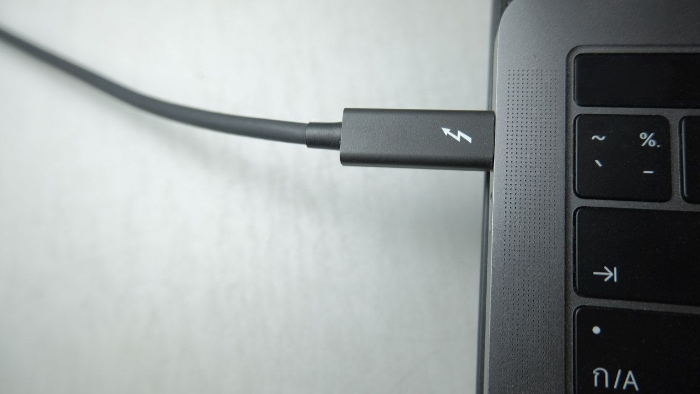Thunderbolt 3 vs. USB 3.2: From Ports to Possibilities

Connectivity standards like Thunderbolt 3 and USB 3.2 are at the heart of how we interact with our devices, shaping everything from how quickly we can transfer files to the way we charge our gadgets.
These technologies, while seemingly similar, offer distinct advantages and limitations that can significantly impact your digital lifestyle.
Overview and Key Features of Thunderbolt 3
Thunderbolt 3 stands as a remarkable advancement in connectivity technology, merging the speed of PCI Express with the versatility of USB-C to create a powerful, all-in-one interface. Its introduction marked a significant leap forward, offering unprecedented data transfer rates, video bandwidth, and power delivery over a single, compact connector.
Designed to enhance user experience across a wide array of devices, Thunderbolt 3 simplifies connections while pushing the boundaries of what's possible with technology today.
High-Speed Data Transfer
Thunderbolt 3 boasts an impressive data transfer rate of up to 40 Gbps. This speed is double what its predecessor offered and four times faster than the latest USB standards available at its launch.
Such velocity transforms file transfers, reducing times dramatically and facilitating more efficient workflows, especially for professionals dealing with large files like high-resolution videos and detailed 3D models.
Versatile Connectivity
A single Thunderbolt 3 port can do it all—charge devices, transmit data, and output video. Its ability to daisy-chain up to six devices off a single connection streamlines workspace setups and reduces cable clutter.
This feature is particularly beneficial for users who need to connect multiple peripherals, like external hard drives, monitors, and audio interfaces, without sacrificing speed or quality.
Universal USB-C Port
The adoption of the USB-C connector with Thunderbolt 3 was a game-changer. This reversible connector not only makes it easier to plug in devices without worrying about orientation but also ensures Thunderbolt 3's compatibility with a wide range of devices.
From laptops and smartphones to docking stations and external GPUs, the universal port design facilitates a seamless connection ecosystem.
Power Delivery
Thunderbolt 3 can deliver up to 100 watts of power, enabling users to charge laptops and other devices directly through the connection. This power delivery capability, combined with data transfer and video output, makes it an ideal single-cable solution for docking stations, minimizing the need for additional power adapters and cables.
Enhanced Video Capabilities
Supporting dual 4K displays or a single 8K display, Thunderbolt 3 is a boon for video professionals and enthusiasts alike. The high bandwidth allows for the transmission of vivid, detailed imagery at fast refresh rates, essential for high-end video editing, gaming, and virtual reality applications.
Overview and Key Features of USB 3.2
USB 3.2 represents the latest evolution in the Universal Serial Bus (USB) standard, aimed at enhancing the speed and efficiency of data transfer between devices. As technology continues to advance, the need for faster data transmission rates has become increasingly important.
USB 3.2 addresses this demand by offering improved bandwidth and compatibility, ensuring users can enjoy quicker file transfers and more efficient connectivity. This update to the USB standard underscores a commitment to innovation, providing a versatile and powerful solution for a wide range of tech applications.
Enhanced Data Transfer Speeds
One of the standout features of USB 3.2 is its increased data transfer speeds, offering rates up to 20 Gbps with the USB 3.2 Gen 2×2 specification. This is a considerable jump from earlier versions, facilitating faster file transfers and more responsive device interactions.
For users dealing with large volumes of data, such as video editors or gamers, the speed enhancements of USB 3.2 can significantly impact productivity and performance.
Improved Bandwidth Utilization
USB 3.2 introduces more efficient bandwidth utilization, allowing for dual-lane operation in devices equipped with USB Type-C ports. This development means that data can flow more freely and at higher rates, enhancing overall transfer efficiency.
By maximizing the capabilities of the USB-C connector, USB 3.2 ensures users can achieve the best possible performance from their devices and peripherals.
Backward Compatibility
A key advantage of USB 3.2 is its backward compatibility with existing USB devices and cables. This means users can upgrade to devices supporting USB 3.2 without needing to replace their current peripherals and cables.
This backward compatibility ensures a smooth transition to the new standard, minimizing disruption and additional expenses for users.
Versatile Connectivity Options
USB 3.2 maintains the versatility of the USB standard, supporting a wide range of device types and connectivity needs. Whether connecting storage devices, peripherals, or charging gadgets, USB 3.2 offers a reliable and efficient solution.
Its support for various data and power delivery protocols ensures that USB 3.2 can meet the demands of a diverse array of tech applications.
Key Differences Between Thunderbolt 3 and USB 3.2

When comparing Thunderbolt 3 and USB 3.2, it's clear that both technologies have significantly shaped the way we connect and use our devices. Each offers unique advantages and features tailored to different user needs and applications.
Data Transfer Speed
Thunderbolt 3 stands out with its impressive data transfer rate of up to 40 Gbps, which is double the maximum speed offered by USB 3.2 Gen 2×2 at 20 Gbps. This distinction is crucial for professionals who rely on rapid data transfers for large files, such as high-resolution video editing or extensive data processing tasks.
The higher bandwidth of Thunderbolt 3 facilitates a smoother and more efficient workflow, making it a preferred choice for demanding applications.
Connectivity and Daisy-Chaining
Thunderbolt 3 also excels in connectivity options, allowing users to daisy-chain up to six devices through a single port. This capability is not available with USB 3.2, which requires separate connections for each device.
For users who need to connect multiple devices simultaneously, such as monitors, storage drives, and audio interfaces, Thunderbolt 3 offers a more streamlined and clutter-free setup.
Power Delivery
Both Thunderbolt 3 and USB 3.2 support power delivery over their connections, but Thunderbolt 3 can supply up to 100 watts of power, compared to the maximum of 4.5 watts typically provided by USB 3.2. This higher power output makes Thunderbolt 3 more suitable for charging laptops and other high-power devices directly through the data connection, providing a more convenient and efficient charging solution.
Compatibility and Availability
USB 3.2 boasts broader compatibility and availability across a wide range of devices and peripherals, thanks to its backward compatibility with previous USB standards. This universality means that USB 3.2 devices are generally more accessible and affordable than those requiring Thunderbolt 3.
For everyday users and consumer electronics, USB 3.2 offers a versatile and widely supported option for connecting a variety of devices.
Video Output
Thunderbolt 3 supports the connection of multiple displays, including dual 4K monitors or a single 8K display, through a single connection. While USB 3.2 can also support video output, its capabilities are typically limited in comparison, making Thunderbolt 3 the better option for professionals in video production or users who require high-resolution multi-display setups.
Practical Applications and Use Cases
Thunderbolt 3 and USB 3.2 are both powerful connectivity standards that cater to a wide range of applications, from everyday tasks to professional workloads. Each standard shines in different scenarios, leveraging their unique features to enhance user experiences across various devices and systems.
Thunderbolt 3 Applications
With its high data transfer speed of up to 40 Gbps, Thunderbolt 3 is ideal for video editors and content creators who regularly work with large files. The ability to quickly move raw footage and render videos saves valuable time in a professional workflow.
Thunderbolt 3's support for daisy-chaining also allows for a clean and efficient setup with multiple external drives and monitors.
High-Performance Computing
Thunderbolt 3's support for external graphics cards (eGPUs) makes it a popular choice among gamers and professionals who require additional graphical processing power. Users can easily connect an eGPU to a laptop for enhanced performance in gaming, VR applications, and data-intensive tasks such as 3D rendering and computational simulations.
Simplified Docking Solutions
For users who need to connect multiple devices to their laptop, including monitors, keyboards, mice, and network connections, Thunderbolt 3 docks offer a convenient solution. A single Thunderbolt 3 connection can provide data transfer, video output, and charging, reducing cable clutter and simplifying the workspace.
USB 3.2 Applications
USB 3.2, with its data transfer rates of up to 20 Gbps for Gen 2×2, is well-suited for general data transfer needs. It is ideal for moving files between storage devices, backing up photos, videos, and documents, and other common tasks that benefit from fast data speeds.
Consumer Electronics Connectivity
USB 3.2's widespread compatibility makes it the go-to standard for connecting a variety of consumer electronics, including smartphones, tablets, cameras, and portable storage. Its ability to deliver power along with data transfer makes it convenient for charging and syncing devices.
Peripheral Device Connection
Keyboards, mice, webcams, and headsets commonly utilize USB connections for their reliability and ease of use. While these peripherals do not typically require the high data transfer speeds of USB 3.2, they benefit from the standard's compatibility and power delivery capabilities, ensuring wide support across various devices and systems.
Conclusion
Choosing between Thunderbolt 3 and USB 3.2 comes down to understanding each standard's unique strengths and how they align with individual needs. Thunderbolt 3 shines in high-bandwidth applications, offering exceptional speed and versatility for professionals in content creation, gaming, and those requiring advanced docking solutions.
Its ability to daisy-chain devices and support high-power charging makes it a powerful tool for creating efficient, streamlined workspaces. On the other hand, USB 3.2 provides significant advantages for general data transfer and connectivity, catering to a broader range of devices and everyday uses.
Its compatibility and speed enhance a wide array of tasks, from simple file transfers to connecting consumer electronics and peripherals.


